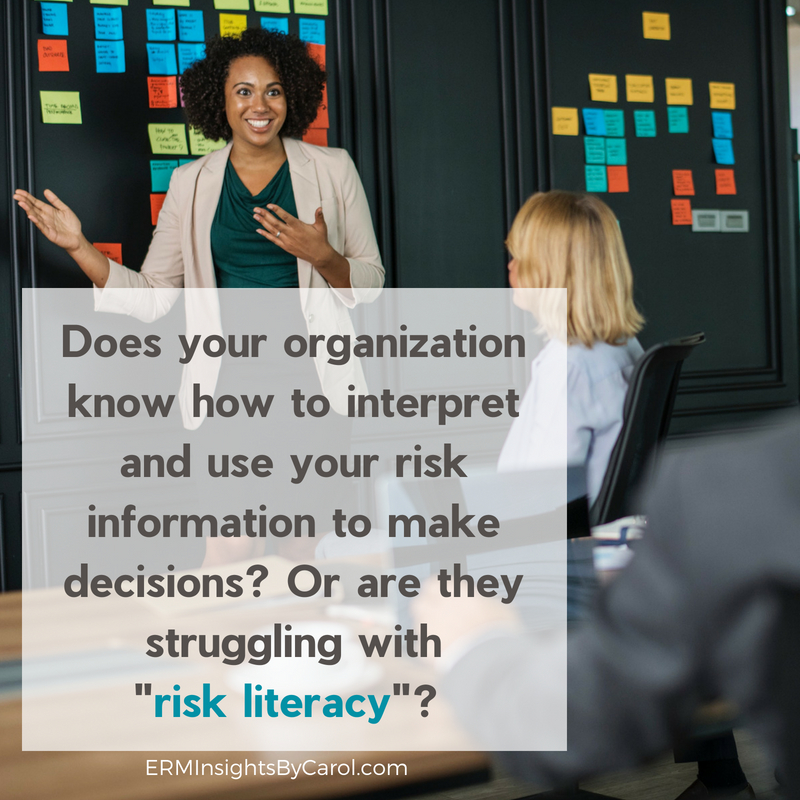Math is not my strong suit. I feel more at ease at the keyboard, weaving words together. That’s not to say I’m terrible at math. In fact, I passed a rigorous calculus course in high school, and I actually enjoyed business statistics. But those days are in the distant past, and I rarely have occasion to use what I learned in those classes.
Or, at least, that’s what I thought.
According to the article, How well do you think about risk and uncertainty?, we’re all faced with risk decisions on a regular basis…and many of us are failing.
Here are a few real-life examples of risks you may be dealing with:
- There’s a 40% chance of rain tomorrow. How do you interpret this forecast?
- A new drug touts a 50% reduction in plaque build-up in your arteries. What do you need to know to determine if you might benefit from using the drug?
- Your doctor tells you that you have a genetic disposition to a certain kind of cancer. Do you undergo surgery or other medical treatment or wait to see if the cancer presents itself?
- You receive an offer regarding a financial investment that seems to have a high rate of return. Do you go for it?
If these questions leave you scratching your head, you’re not alone. Many people struggle with “risk literacy,” or the ability to cope with risk and uncertainty and to use those factors to make good decisions.
Edward Cokely of the University of Oklahoma has developed a quick test to measure your risk literacy. Click here to read the article and access the test.
Communicating Risk and Uncertainty at Work
As an ERM professional, you spend your days identifying, assessing, managing, and reporting risk information. It’s up to the decision-makers—from line staff to the board—to use that information to make the best decisions possible. In fact, helping the organization make risk-informed decisions is the ultimate goal of ERM.
However, if those decision-makers struggle with risk literacy, they may misunderstand your carefully-charted risk information. They may also misunderstand how to apply the information to the many decisions they have to make in a given day. This disconnect can leave both of you feeling frustrated, as they struggle to find value in your risk information.
Fortunately, there are actions you can take to help your business customers understand your risk information better and use it to make good decisions.
1) Use concrete terms
It’s often a good idea to use percentages when talking about probability and impact. However, you should communicate those percentages in concrete terms, as well. For example, you identify a risk that a key piece of machinery may break down 10% of the time. Instead of leaving your business customer to interpret that figure, do the math for them, and explain that this would equate to 4 hours of down-time out of every 40-hour week.
2) Speak their language
When you talk about risk, put it in terms that make sense to your business customer. For example, the ultimate impact of having a key piece of machinery go idle for 4 hours a week could be millions of dollars in lost sales due to decreased productivity. However, managers of line workers may not appreciate this kind of impact, since it doesn’t directly impact them. When speaking with such managers, you could talk about the impact on their jobs and staff, such as having 5 people twiddling their thumbs for 4 hours a week (something they would have to manage).
3) Identify individual risk appetites
While some people are risk averse, others thrive on the opportunities risks present. When working with others to score risks, identify mitigations, and create action plans, it’s a good idea to get a handle on their personal risk appetites. This can help you understand the information you receive so you can present it in a more balanced light to the C-suite or board (who may be more risk-seeking than lower-level managers).
4) Use scenario analysis
Scenario analysis (or scenario planning, as I like to call it) is an excellent tool to test assumptions as well as possible scenarios. Use it to help managers and executives alike to determine the potential positive, neutral, and negative outcomes of a certain action before they make the decision to act. Not only can this help the organization make better risk-informed decisions, but it can help train individuals on how to apply risks to their decision-making process.
And that’s the good news: we can increase our risk literacy through practice and education. Since the primary goal of ERM is to help the organization make risk-informed decisions, use these four approaches as often as possible to strengthen the risk literacy of your organization.
What steps have you taken to help executives, managers, and workers in your organization improve risk literacy? Have you seen improved decision-making as a result?
I’m interested to learn more about your experiences with risk literacy in your organization. Please feel free to join the conversation on LinkedIn.
And if you’re struggling to deliver usable risk information to decision-makers, please contact us today to discuss options you can immediately implement to boost your organization’s risk literacy.
About the author
Ashley Jones joined ERM Insights by Carol in June 2017. She graduated from Florida State University in 2003 with a B.A. in Risk Management and Insurance and obtained the Project Management Professional (PMP) designation in May 2012. Ashley has fourteen years of experience in the fields of insurance and risk management, most notably as a Senior Risk Analyst within the ERM department of a $7+ billion property and casualty insurance company. When she’s not working on project or risk management, Ashley is busy writing, blogging, teaching, and speaking on a wide variety of topics.








